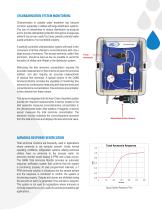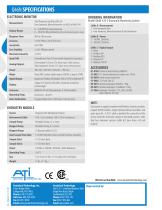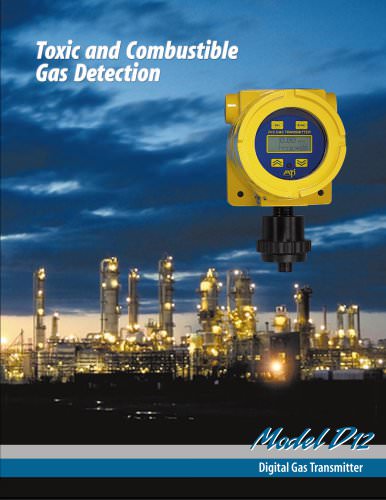
Catalog excerpts

On-Line monitoring of Ammonia in water is of increasing importance due to the increased emphasis on nutrient reduction in lakes, streams, and estuaries. Unfortunately, simple direct measuring sensors have not proven sufficiently reliable, and rather complicated systems have been developed to address the measurement problem. These systems can be used but require substantial maintenance and are expensive to purchase. ATI has developed a new approach to on-line monitoring of ammonia that is easier to operate and less expensive than competitive systems, but with the reliability you need. • Fast response time for real time ammonia measurement • Simple chemical system uses inexpensive reagents • Display of Free Ammonia, Monochloramine, and Total Ammonia for chloramination systems • Automatic response verification for ammonia breakthrough applications • Multiple digital communication options: Profibus, Modbus, or Ethernet Call 800.959.0299 to speak with a sales representative or visit us on the web at www.analyticaltechnol
Open the catalog to page 1
Chloraminated Potable Water Wastewater Effluent Potable Water Intake Ammonia Chillers Fish Farms OPERATION Waste Ammonia measurement is accomplished by the addition of three reagents, each of which is fed using a multichannel peristaltic pump. A stabilizer chemical is injected first to stop calcium precipitation in the tubing. After that, a solution containing free chlorine is injected which results in the conversion of ammonia to monochloramine. NH4+ + HOCl → NH2Cl + H+ + H2O The third reagent added quenches the above reaction by removing the excess free chlorine. This ensures that free...
Open the catalog to page 2
CHLORAMINATION SYSTEM MONITORING Chloramination in potable water treatment has become common, especially in utilities with large distribution systems. The use of chloramines to reduce disinfection by-products and to provide disinfectant protection throughout a large pipe network has proven useful but does present potential water quality problems if not controlled properly. A carefully controlled chloramination system will result in the conversion of all free chlorine to monochloramine with only a slight excess of ammonia. This excess ammonia, called “free ammonia”, should be kept as low as...
Open the catalog to page 3
ELECTRONIC MONITOR Measurement ORDERING INFORMATION Model Q46N-A-B-C Ammonia Monitoring System Suffix A - Measurement 1 - Total Ammonia Only 2 - Free Ammonia, Monochloramine & Total Ammonia Suffix B - Power 1 - 120 VAC, 50/60 Hz. 2 - 230 VAC, 50/60 Hz. Suffix C - Digital Output 1 - None 2 - Profibus-DP 3 - Modbus-RTU 4 - Ethernet-IP 5 - Modbus-TCP/IP ACCESSORIES 07-0100 Universal Junction Box, NEMA 4X 31-0027 9-c Sensor interconnect cable, max. 100 ft. 05-0094 Panel mount bracket kit 47-0005 2" U-bolt, 304 SS 09-0074 Ammonia Reagent A Buffer, 1 Pkg. 09-0075 Ammonia Reagent C Stabilizer, 1...
Open the catalog to page 4All Analytical Technology catalogs and technical brochures
-
C12-17
2 Pages
-
F12/D
4 Pages
-
D16 PortaSens III
4 Pages
-
ChlorLog
2 Pages
-
Model Q46H/83
4 Pages
-
E12-15 IR
2 Pages
-
Metrinet
4 Pages
-
B12 Wet Gas Detector
2 Pages
-
B14 Gas Alarm Module
4 Pages
-
Q45S Wet H2S Gas Detector
4 Pages
-
A14/A11 Modular Gas Detector
8 Pages
-
Model Q45N
4 Pages
-
Q45H/64
2 Pages
-
Q45C2
2 Pages
-
Q22PX
2 Pages
-
Model Q45P/R
2 Pages









































